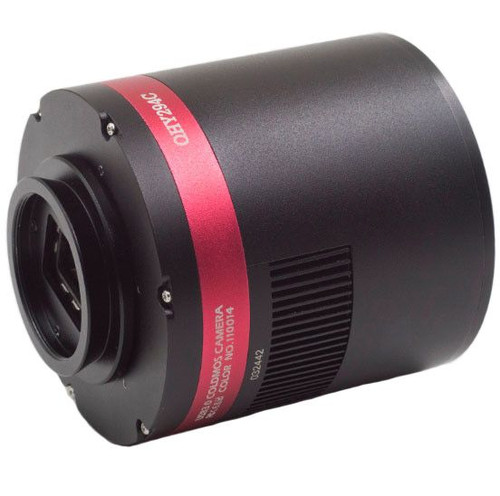Product Overview
The294Pro has 11.7 MP at 4.63um, 14-bits A/D. IMX492 chips have 46.8 million 2.315um pixels, which Sony 2×2 bins on-chip to create the sensor’s advertised 11.7 million 4.63um pixel array.
The QHY294 Pro CMOS sensor has a dual gain mode, HGC (high gain) and LGC (Low gain). The QHY294 Pro will switch the two modes automatically when the gain is set to 1600 you will get the benefits of the ultra low read noise (1e- to 1.6e-) of the HGC mode and a full well capacity of about 14.5ke- at the switch point setting.
One benefit of the back-illuminated CMOS structure is improved full well capacity. In a typical front-illuminated sensor, photons from the target entering the photosensitive layer of the sensor must first pass through the metal wiring that is embedded just above the photosensitive layer. The wiring structure reflects some of the photons and reduces the efficiency of the sensor.
In the back- illuminated sensor the light is allowed to enter the photosensitive surface from the reverse side. In this case the sensor’s embedded wiring structure is below the photosensitive layer. As a result, more incoming photons strike the photosensitive layer and more electrons are generated and captured in the pixel well. This ratio of photon to electron production is called quantum efficiency. The higher the quantum efficiency the more efficient the sensor is at converting photons to electrons and hence the more sensitive the sensor is to capturing an image of something dim.
In the DSLR implementation there is a RAW image output, but typically it is not completely RAW. Some evidence of noise reduction and hot pixel removal is still visible on close inspection. This can have a negative effect on the image for astronomy such as the “star eater” effect. However, QHY Cameras offer TRUE RAW IMAGE OUTPUT and produces an image comprised of the original signal only, thereby maintaining the maximum flexibility for post-acquisition astronomical image processing programs and other scientific imaging applications.
Based on almost 20-year cooled camera design experience, The QHY cooled camera has implemented the fully dew control solutions. The optic window has built-in dew heater and the chamber is protected from internal humidity condensation. An electric heating board for the chamber window can prevent the formation of dew and the sensor itself is kept dry with our silicon gel tube socket design for control of humidity within the sensor chamber.
Cooling
In addition to dual stage TE cooling, QHYCCD implements proprietary technology in hardware to control the dark current noise.
| Model | QHY294M Pro |
| CMOS Sensor | SONY IMX492 |
| Mono/Color | Mono Only |
| FSI/BSI | BSI |
| Pixel Size | 4.63μm*4.63μm |
| Effective Pixel Area | 4164*2796 |
| Total Pixel Area | – |
| Effective Pixels | 11.7 MP 46.8 MP(Extended Pixel Mode) |
| Sensor Size | 4/3 inch (19.28mm*12.95mm) |
| A/D | 14-bit A/D |
| Full Well Capacity (1×1, 2×2, 3×3) | 65ke- |
| Frame Rates | Standard 11.6mega pixel mode Full resolution: 16.5FPS@14bit ROI: 2160lines 21FPS 1080lines 41FPS 960lines 46FPS 768lines 56FPS 480lines 87FPS 240lines 156FPS 100lines 290FPS47mega pixel mode 8340*5644 4FPS@14bit and 8bit |
| Readout Noise | 1.6- to 1.2e- (High Gain Mode) 6.9- to 5.2e- (Low Gain Mode) |
| Dark Current | 0.002e-/pixel/sec @-20℃ 0.005e-/pixel/sec @-10℃ |
| Exposure Time Range | 60μs-3600sec |
| Recommend Gain* | 1600 (11MP Mode) 2600 (47MP Mode) |
| Amp Control | Amplifer Glow Can be reduced during long exposure |
| Shutter Type | Electronic Rolling Shutter |
| Computer Interface | USB3.0 |
| Built-in Image Buffer | 256MB DDR3 Memory Buffer |
| Cooling System | Dual Stage TEC cooler(about -35℃ below ambient, test temperature +20℃) |
| Optic Window Type | AR+AR High Quality Multi-Layer Anti-Reflection Coating |
| Telescope Interface | M42/0.75 |
| Back Focal Length *Learm more: https://www.qhyccd.com/adapters/ |
17.5mm(±0.2) |
| Anti-Dew Heater | Available |
| Humidity Sensor | – |
| Firmware/FPGA remote Upgrade | – |
| Weight | 650g |






















